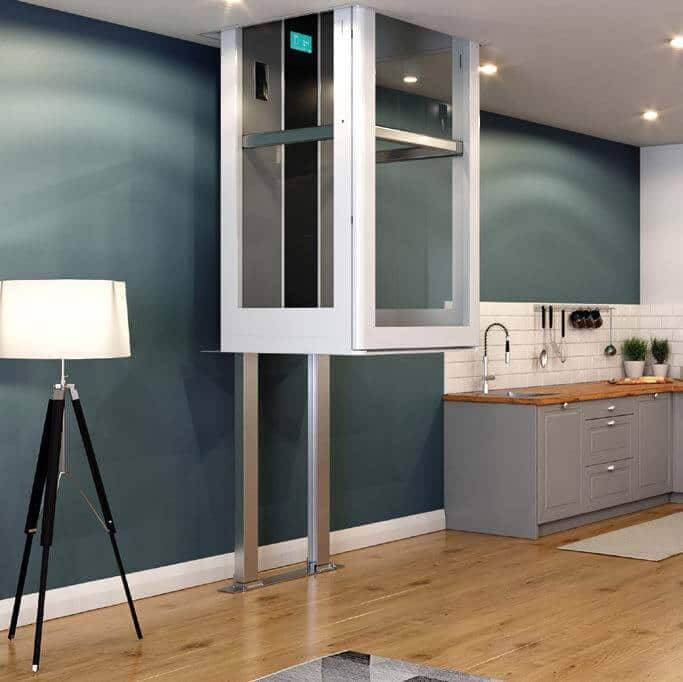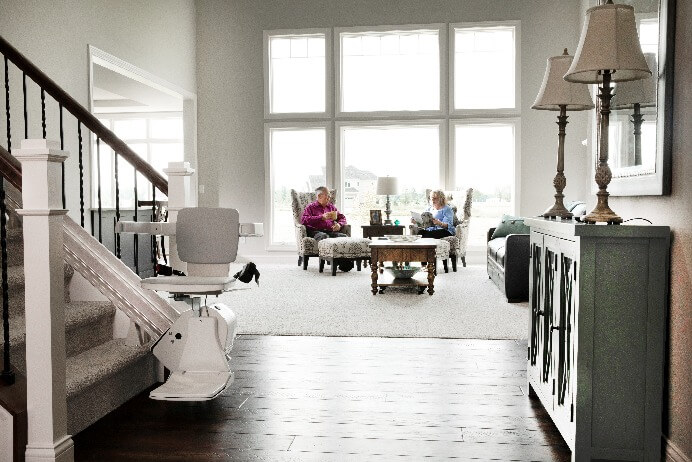Comparing the Costs: Home Elevator vs. Stair Lift

Navigating through multi-story homes can be challenging as we age or for those with mobility limitations. Hence, the demand for home elevators and stair lifts has surged.
These devices not only offer comfort and independence but also enhance the value of your home.
Cost plays a significant role when deciding between a home elevator and a stair lift. It’s not just the initial purchase price; one must consider installation, maintenance, and operation costs over time.
This post presents a detailed cost comparison to help you determine your home accessibility needs.

Understanding the Basics: Home Elevator vs. Stair Lift
When it comes to making your home accessible, two of the most common solutions are home elevators and stair lifts.
A home elevator and stair lift, while both designed to improve home accessibility, differ fundamentally in several ways. A home elevator is a vertical transportation device designed for residential use, providing convenient access between different levels of a house.
On the other hand, a stair lift is a mechanized chair that moves along a rail system fitted to your staircase, meant for individuals able to transfer from a wheelchair or walk with minimal assistance.
Each has unique offerings, and your choice will largely hinge on your specific needs, home configuration, and budget.
How does a home elevator work?
A home elevator operates much like a commercial elevator, albeit on a smaller scale and with specific features tailored to residential use.
Installed within a shaft in your home, it uses a motorized system to lift and lower the elevator car between floors.
Home elevators are controlled by a simple push-button panel, allowing users to select their desired floor easily. It is also designed with safety in mind, incorporating features such as emergency stop buttons, safety sensors, and backup power systems.

How does a stair lift work?
A stair lift operates on a straightforward principle, offering a simple and efficient way to traverse the staircase.
It comprises a chair attached to a rail system installed along the stairway. The user can comfortably sit on the chair, secure the safety straps, and use the control panel or remote control to activate the lift.
Stair lifts or chair lifts are versatile and can be customized to accommodate straight, curved, or multi-level staircases.
They are also equipped with safety features, including seat belts, swivel seats for easy dismount, and sensors to detect obstacles on the stairs.

What Are the Costs of a Home Elevator?
Home elevators can vary significantly in cost. Factors such as size, weight capacity, type of drive (hydraulic or cable), and cabin configuration influence the cost.
Before installing residential elevators, you should know of the following costs associated with the project:
Initial installation costs
The initial installation costs of a home elevator can be considerable, largely dependent on the elevator’s type and the specifics of your home’s structure.
For instance, while offering a smoother ride, hydraulic elevators typically cost more because they require a machine room and a pit.
On the other hand, cable-driven systems might be less expensive up front, but they require more maintenance over time, which could contribute to higher long-term costs.
These costs include alterations to the home’s structure, like reinforcing the floor and creating an elevator shaft.
On average, the installation of a home elevator can range from $25,000 to $70,000, with high-end models potentially costing even more.
It is essential to consult with a professional installer to get an accurate quote based on your unique needs and home configuration.
Maintenance costs
Home elevators’ maintenance costs should also be considered when making a purchase decision.
A platform lift includes regular maintenance and annual inspections to ensure the safe operation of your elevator. This includes oil and lubricant changes, belt replacements, alignment checks, panel cleaning, etc.
Depending on the model and manufacturer’s recommendation, you can expect to spend anywhere from $500 to $1000 for annual maintenance, with additional costs depending on any needed repairs or part replacements.
Potential additional costs
In addition to the initial installation and maintenance costs, homeowners may incur several potential additional costs when installing home elevators.
For instance, there may be the need for electrical upgrades to power the elevator, which can cost several hundred dollars. Also, if your home elevator requires a separate machine room, additional construction and wiring costs could be added.
Furthermore, some homeowners might customize their elevator’s interior with high-end finishes, lighting, and floorings, increasing their overall expenditure.
Additionally, there are indirect costs related to increased energy consumption and potential changes to your homeowner’s insurance policy due to the increased value of your home after installing an elevator.
What Are the Costs of Stair Lifts?
Wheelchair users who cannot climb the stairs may opt for a stair lift as an alternative to a home elevator. Stair lifts, like their vertical counterparts, also come in different types and can differ significantly in cost depending on the customization and features required.
The overall costs of installing a stair lift include initial installation, maintenance, battery replacement, additional labor fees for removal or upgrades, and potential additional costs.
Initial installation costs
To have the right stair lift installed in your home, you need to consider the type of staircase in your house (straight or curved) and any obstacles on the stairs that must be avoided.
A straight stair lift’s initial installation costs typically range from around $3,500 to $5,000. It is also essential to consider that the installation cost depends on which model you purchase.
Maintenance costs
Stair lifts should be regularly inspected and maintained to ensure they work correctly. The maintenance cost depends on the manufacturer’s recommendation but typically ranges from $250 to $300 per hour, depending on the model and the service provider.
Potential additional costs
Additional costs can be incurred just like any platform or porch lift. Battery replacement is one such cost, which is around $100, depending on the model and size of the battery.
You may also incur additional labor fees if you remove the stair lift later or upgrade certain features, such as motors or switches. Additionally, there might be local taxes needed for permits and inspections that need to be considered.
What Are Factors Influencing the Cost of Home Elevators and Stair Lifts?
Following the specifics of the cost comparison between home elevators and stair lifts, it’s vital to understand the multitude of factors that can significantly impact the overall cost.
These factors range from the type and model of the lift to the home’s architecture, local regulations, and the degree of customization required. The following section will provide an in-depth look at these influencing factors.
Complexity of installation
Several factors influence the complexity of installation for both home elevators and stair lifts.
For home elevators, the obstructions in the proposed flexible installation locations, hydraulic elevators need a separate machine room, and the structural changes required in the home significantly affect the complexity.
Meanwhile, for stair lifts, factors such as the layout and shape of the staircase (straight or curved), obstacles on the stairway, narrow staircases, and the power source can significantly add to the complexity of installation.
Furthermore, local building codes and regulations may also impact the installation process and timeline in both cases.
Size of home elevator or stair lift
Size is primarily determined by the available space in your home and the elevator’s intended capacity, which can range from one to multiple passengers.
A larger elevator will require more space and potentially more extensive construction modifications, increasing costs.
In the case of stair lifts, the size can be dictated by the width of your staircase and the user’s requirements. For instance, a stair lift designed for a larger person may require a broader seat and stronger motor, increasing its cost.
Moreover, size may also relate to the length of the track for the stair lift, mainly if your staircase is long or curved, which adds to the installation complexity and cost.
Brand of home elevator or stair lift
Brand names always play a massive role in any commercial item. Notably, brands vary in reputation, quality of materials used, design aesthetics, technology incorporated, and customer service.
Some brands offer premium products with advanced features, superior materials, and sleek designs that command higher prices.
These brands may also have exceptional customer service, with comprehensive warranties and responsive after-sales support, which might be factored into their higher costs.
On the other hand, more affordable brands might cut costs by using less expensive materials, offering fewer customization options, or reducing included services like maintenance.
While these brands can provide cost savings upfront, it’s essential to consider potential long-term costs related to durability and maintenance.
It’s crucial to balance cost and quality, ensuring that the chosen product meets your needs and provides good value.
Customization options
For home elevators, customization options include the choice of finishes and materials, the type of doors, the inclusion of special features, or even the shape and size of the cabin.
These modifications can increase the aesthetic appeal and functionality of the elevator but also raise the cost significantly.
Similarly, stair lifts can be customized to suit users’ needs and preferences.
This could involve altering the seat size, adding a swivel or retractable seat belt for safety, incorporating controls for easy operation, or varying the color to blend with the home’s decor.
The cost can rise substantially with these customizations, but they can significantly enhance the stair lift’s comfort, safety, and convenience.
It’s important to remember that while customization can lead to a more personalized and satisfying end product, it will usually increase costs. Always evaluate the necessity and value of each customization option against your budget to make a well-informed decision.
Which Is the More Cost-Effective Solution: Home Elevator vs. Stair Lift?
When considering the cost of a home elevator or stair lift, it’s essential to consider your individual needs and preferences.
Home elevators offer more advantages for wheelchair users and those with impaired mobility due to their larger capacity and greater ease of access. Still, they are usually more expensive than stair lifts.
For younger individuals or elderly people who need only occasional assistance, a stair lift may be a better option. It provides the convenience and safety of avoiding stairs at a much lower cost than an elevator.
However, individuals with larger homes or more complex designs may find that elevators are the best solution for their needs, allowing them to move freely between floors in comfort and style.
It’s essential to weigh up all of the factors discussed above before making your decision. At Ascend Residential Elevators & Lifts, our experienced team can help you find the perfect balance between cost and quality for your home elevator or stair lift.
Contact us today so that we can guide you through this process and provide you with a tailored solution to meet your needs.
